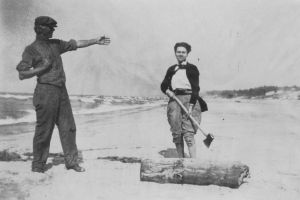Concert
Ensemble Modern I
Portrait Ruth Crawford Seeger: Songs
David Niemann, conductor
León / Balch / Crawford Seeger / Beyer

An axe for the frozen sea within us: Ruth Crawford Seeger, a log and friend Carl Sandburg, c. 1930 © peggyseeger.com
The composer Ruth Crawford Seeger was not only part of the ultramodernist movement that sought to investigate the possibilities of music beyond European traditions, she was also a researcher into the folkloric music of the USA and influenced by the Theosophists. A woman of her time, the fast-moving inter-war years, and yet so far ahead of them – Musikfest Berlin and Ensemble Modern dedicates a three-part concert portrait to her that enables her musical world to enter a dialogue with contemporaries and present-day composers.
Transcending tonality, highly expressive yet with a clear structure: Ruth Crawford Seeger, who lived in Berlin at the beginning of the 1930s with the aid of a Guggenheim Fellowship, was a distinctive and pioneering figure in American modernism. She composed highly original works such as the “Three Songs” to poems by Carl Sandburg, a cycle that often adopted surreal features in which two independent sound groups meet: a “concertino” and an “ostinato” of thirteen players to be seated as far away from the soloists as possible. In the first of the three concerts that the Ensemble Modern devotes to Ruth Crawford Seeger’s oeuvre, the programme also includes her two ricercari “Sacco, Vanzetti” and “Chinaman, Laundryman”, whose half-sung, half-spoken texts tell of the hardship of exploited immigrants and the controversial Sacco-Vanzetti trial of 1921, in which two Italian Americans were condemned to death in questionable circumstances. By contrast, humour and narrative economy similar to that of Prokofiev’s “Peter and the Wolf” can be found in the suite for children “The Adventurer of Tom Thumb”, whose lyrics were written by the composer herself based on the Brothers Grimm. The evening is introduced by the electronic composition “Music of the Spheres” written in 1938 by the New York composer Johanna Beyer: a stream of sound composed for “electrical instruments” and triangle that was far ahead of its time. There is also a chance to hear the fantastic sound worlds of Katherine Balch’s “waste knot” for soprano, four amplified dictaphones, and ensemble and Tania León’s “Indígena” for chamber ensemble.
Programme
Johanna Magdalena Beyer (1888 – 1944)
Music of the Spheres (1938)
for three electronical instruments
Ruth Crawford Seeger (1901 – 1953)
Five Songs (1929)
to poems by Carl Sandberg
for contralto and piano
Tania León (*1943)
Indígena (1991)
for chamber ensemble
Ruth Crawford Seeger (1901 – 1953)
Three Songs (1930 – 32)
to poems by Carl Sandberg
for voice, oboe, piano, percussion, and optional orchestral ostinato
The Adventures of Tom Thumb (1925)
for three electronical instruments
Katherine Balch (*1991)
waste knot (2021/22)
for soprano, four amplified dictaphones, and ensemble
Ruth Crawford Seeger (1901 – 1953)
Two Ricercare (1932)
to poems by H. T. Tsiang
for voice and piano
Tania León (*1943)
Singin’ Sepia (1996)
Five Songs by texts from Rita Dove
for voice and three instruments
Contributors
Amanda Becker – soprano (Crawford Seeger)
Nina Guo – soprano
Keren Motseri – soprano
Ensemble Modern
David Niemann – conductor
Paul Jeukendrup – sound direction
An event by Berliner Festspiele / Musikfest Berlin
Supported by the Capital Cultural Fund
Ensemble Modern would like to thank the Library of Congress in Washington for its kind support in researching Ruth Crawford Seeger’s music.
With the kind support of the Ensemble Modern Patronatsgesellschaft e.V.